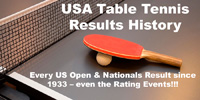While you should vary your spin serves to all parts of the table - at least until you find out what gives your opponent trouble and what doesn't - there are certain spin serves that are generally more effective when done to specific parts of the table.
The main principle to remember is that, in general, opponents will have more trouble returning a serve that spins away from them than one that spins into them. For example, when a righty serves a forehand pendulum serve to another righty (so that the ball breaks to the server's right, the receiver's left), if the ball is served to the wide backhand, the ball spins away from the receiver, and is usually harder to receive than the same serve to the forehand, where it breaks into the receiver. Similarly, a backhand or tomahawk serve to the forehand is generally more difficult to receive than one to the backhand, since it also breaks away from the receiver (to the server's left, the receiver's right). There are three reasons for this.
First, a receiver has to move or reach for a serve that breaks away. This makes it trickier to control as he may be hitting on the move.
Second, while the receiver may set up with his racket at the right height to receive the serve, when the ball breaks away and he moves or reaches for it there is a tendency to lower the racket. This means he will likely lift the ball too much, and either go off the end or receive soft and high.
Third, to counter the incoming spin the receiver has to aim to the left to receive a ball breaking away on the backhand side, and to the right to receive a ball breaking away on the forehand side. In both cases it's more natural to aim the other way, especially on the forehand side. So countering a sidespin that breaks away is usually more awkward.
Here's a simple way of visualizing this third reason. Imagine a forehand pendulum serve short to your forehand. To counteract the spin, you have to aim to the left, i.e. a normal crosscourt forehand, which is not difficult for most players. In fact, if you wanted to place this ball crosscourt you would want to aim to the left of the table, which isn't that difficult with a little practice. Now imagine a backhand or tomahawk serve short to your forehand side, so the ball is breaking away from you. To counteract the spin, you have to aim to the right, down the line - see how awkward that can be? If you wanted to take it down the line, you'd have to aim to the right of the table, even more awkward. Even advanced players often have trouble with this.
There are always exceptions. Some players are good against balls that break away, and are awful against ones that break into them. Or perhaps you simply are better at one type of sidespin serve, and the opponent will have trouble with it on both sides (especially if you vary the placement), while having little trouble when you use your other, less effective sidespin serve. So experiment - but do so with the knowledge that sidespin serves are usually more effective when placed properly. (And if you haven't yet developed these spin serves, there's no time like now to start learning them!)






